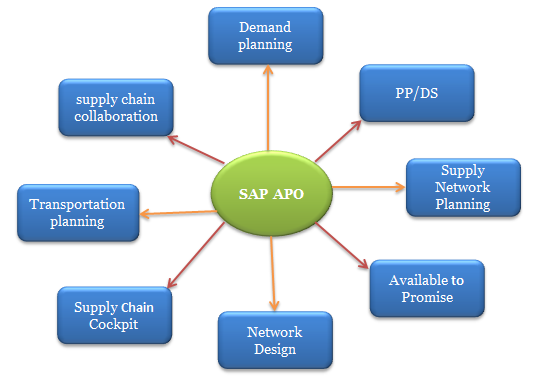What is SAP APO Module
SAP APO stands for advanced planning and optimization and it is one of the most important components of SAP SCM (supply chain management). SAP is one of the biggest vendors of business ERP application software in the world. One of the products that SAP has worked very hard on is the Supply Chain Management business suite, which helps a business to manage its supply chain better while adjusting to constant changes in market conditions and holding on to its business advantage simultaneously.
SAP APO Integration
SAP APO is well integrated with SAP ERP which provides a master and transactions of production, sales, material data, etc so SAP APO is a real-time application that is integrated with other SAP modules. Advanced planning and optimization is a comprehensive suite that includes several supply chain planner applications that provides much better knowledge of the supply chain while enabling forecasting, planning, and optimization.
SAP APO modules
The important components of SAP APO (advanced planning and optimization) are as follows.
Demand Planning: –
- SAP APO’s Demand Planning predicts the market demand for business products.
- Demand Planning is a highly flexible tool that enables the demand planning process in a business.
- Demand planning uses advanced statistical forecasting and sophisticated macro techniques, so it is quite easy to create forecasts that are based on the demand history.
- It also carries out predefined and self-defined tests on many forecast models and predicts the results. It uses a consensus-based approach to adapt to the several demand plans of various departments. Further, promotions and forecast overrides are used to add marketing intelligence and also to enable management adjustments.
Supply Network Planning: –
1. Supply network planning is one of the important components of SAP APO that integrates purchasing, distribution, manufacturing, and transportation which enables tactical planning as well as sourcing decisions to be simulated and implemented by making use of a single unified and consistent model.
2. Supply Network Planning uses the most sophisticated optimization techniques, which are based on constraints and penalties. These techniques are used to plan product flow along the length of the entire supply chain.
3. It enables optimal purchasing, production, and distribution decisions, reduces order fulfillment times as well as inventory levels, and improves customer services effectively.
4. Supply Network Planning also calculates quantities that are to be delivered to a particular location so that the customer demand can be coordinated and an optimal service level can be maintained.
5. It has advanced heuristics and mathematical optimization methods which make certain demand is covered and all resources related to transportation, production, and warehousing are operated within their specified capacities.

Production Planning and Detailed Scheduling (PP/DS): –
1. This SAP APO module enables planning and optimization of production facilities while considering at the same time product and capacity availability.
2. It is used to plan highly critical products, which have a long replenishment lead time and are required to be produced on severely constrained resources.
3. PP/DS enables decreased lead times, speeds up the on-time delivery, enhances the throughput because of better management and planning of resources, and minimizes inventory costs.
Global Availability and Available to Promise (ATP): –
1. Global Availability is another critical SAP APO component used by companies that are required manufacturers to sell products in a global marketplace.
2. Global Availability works by checking availability items that are required, checking for any product allocations that have already been made, and most importantly, having a forecast check.
3. ATP quantity is calculated from the current stock, using planned receipts and the planned requirements. The entire stock is dynamically checked by the system and all the goods movements are perfectly planned.
4. The global ATP checks as well as any existing product allocations that could have been made to certain customers and certain regions that require a much lengthier shipping time.
5. It enables users to identify required planned independent requirements for any incoming sales orders.
Supply Chain Cockpit: –
1. Supply Chain Cockpit is another critical part of SAP APO that provides users with a graphical instrument panel that is used for managing and controlling a supply chain.
2. The configuration of the Supply Chain Cockpit is very easy so that it reflects what are the requirements that are needed for business. The Supply Chain Cockpit is used in different areas such as companies’ strategic planning, demand planning, and production planning.
3. Supply Chain Cockpit is divided into three areas, namely, the upper display – which displays the current settings, consisting of the model, planning work area, planning period, and view, and the tree structure – which is on the left of the screen, and the specific model – which is shown on the right.
Conclusion: –
So SAP APO is one of the best components that support supply chain management (SCM).